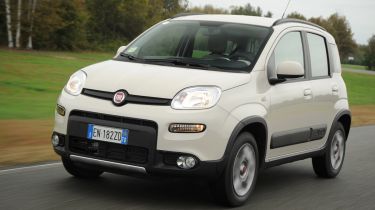New Fiat Panda 4x4
We get behind the wheel of the all-new, third-generation Fiat Panda 4x4 for the first time

The new Panda 4x4 is a worthy range-topper to the city car range. And when combined with the TwinAir engine, it certainly offers a driving experience that’s full of character and just a bit different from the supermini norm. However, the four-wheel-drive system isn’t totally necessary unless you live in a field, so the 4x2 Panda Trekking, which has the same features but is front-wheel drive only, could be a better option. The cheaper, larger Dacia Duster also arrives in UK showrooms just in time for winter, too. But, that said, a Panda 4x4 would embarrass a number of much more expensive current SUVs both on road and off it.
It’s nearly 30 years since Fiat crammed a four-wheel-drive system into a supermini. Taking the latest Panda as its base, this third-generation Panda 4x4 can be had with Fiat’s small but mighty 84bhp TwinAir turbo two-cylinder petrol engine. Added together, the 4x4 promises to be Fiat’s most characterful car.
The more rugged bodykit worn by the 4x4 only helps to enhance the standard Panda’s looks. The blockier front bumper, chunky plastic side sills and 15-inch alloys that are specific to the model all stand out, while the off-road credentials are boosted by uprated suspension that’s 47mm higher than the standard car. There’s also a steel sheet underneath to protect from off-road lumps and bumps, and the engine’s air intake has been raised so you don’t drown it when splashing through deep water.
Fiat also claims that the approach and departure angles are better than those of a MINI Countryman or Nissan Qashqai. Although whether either of these cars ever sees anything more challenging than a grassy car park is a moot point.
Used - available now

2021 Kia
Sportage
44,151 milesManualDiesel1.6L
Cash £14,697
2024 Cupra
Formentor
79,227 milesAutomaticPetrol1.4L
Cash £17,000
2020 BMW
5 Series Touring
44,522 milesAutomaticPetrol2.0L
Cash £19,700
2024 Cupra
Formentor
30,325 milesAutomaticPetrol1.5L
Cash £22,600The interior is relatively unchanged from the regular supermini, although, as the range-topping model, the 4x4 gets climate control, an MP3-compatible stereo, central locking and electric windows and mirrors.
The extra ride height helps the view out, too, only enhancing the already decent visibility of the standard supermini. And while the front seats and 225-litres of boot space are very good, adults rwill struggle for knee room in the back seats.
Turn the key and the TwinAir engine fuzzes into life, sounding more like a moped than a car. The steering, pedals and gearshift are all extremely light - if a little lacking in feel - but the chunky steering wheel and gear knob have a nice solidity to them.
The TwinAir engine is quite vocal and rasps away under the bonnet, even under light throttle loads. It’s not unrefined though, and is a decent performer despite its small size. The 4x4 accelerates from rest eagerly, thanks to a low first gear ratio for more control when off-roading, and easily keeping up with other traffic right up to the motorway limit. That said, at 70mph there’s a fair hiss of wind noise from the base of the A-pillars.
The Panda’s real strong point, though, is its comfortable ride. The extra suspension travel helps smooth out potholes, while off the road, the suspension strikes a sweet spot between absorbing the worst of bumps, while not being so hard that it throws you off line.
There’s very little that stops the Panda off road. Over 90 per cent of the 4x4’s power is fed to the front wheels most of the time, but you hardly even notice when the electro-hydraulic coupling sends power to the back wheels when you’re cornering hard on a wet roundabout, or splashing across a waterlogged field. At speeds below 30mph, you can switch on the electronic diff control, too, using a button behind the gearlever. The system brakes whichever rear wheel is slipping, and feeds power to the opposite wheel, to ensure you keep moving forward.







